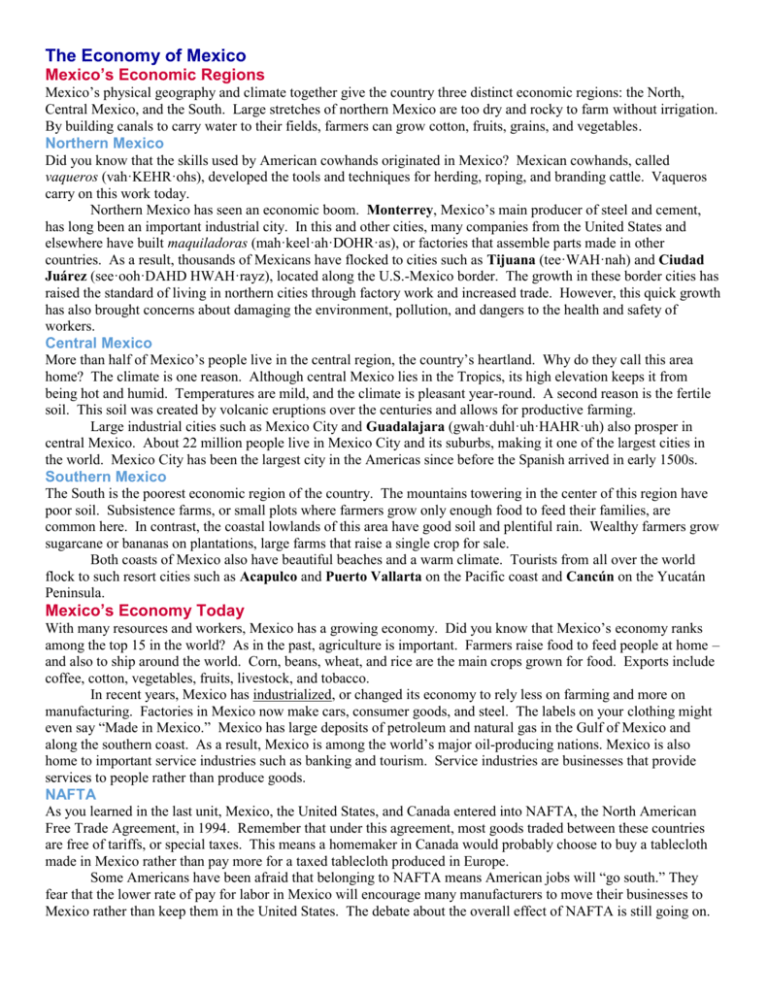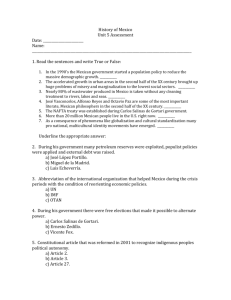The Economy of Mexico Mexico`s Economic Regions
advertisement

The Economy of Mexico Mexico’s Economic Regions Mexico’s physical geography and climate together give the country three distinct economic regions: the North, Central Mexico, and the South. Large stretches of northern Mexico are too dry and rocky to farm without irrigation. By building canals to carry water to their fields, farmers can grow cotton, fruits, grains, and vegetables . Northern Mexico Did you know that the skills used by American cowhands originated in Mexico? Mexican cowhands, called vaqueros (vah·KEHR·ohs), developed the tools and techniques for herding, roping, and branding cattle. Vaqueros carry on this work today. Northern Mexico has seen an economic boom. Monterrey, Mexico’s main producer of steel and cement, has long been an important industrial city. In this and other cities, many companies from the United States and elsewhere have built maquiladoras (mah·keel·ah·DOHR·as), or factories that assemble parts made in other countries. As a result, thousands of Mexicans have flocked to cities such as Tijuana (tee·WAH·nah) and Ciudad Juárez (see·ooh·DAHD HWAH·rayz), located along the U.S.-Mexico border. The growth in these border cities has raised the standard of living in northern cities through factory work and increased trade. However, this quick growth has also brought concerns about damaging the environment, pollution, and dangers to the health and safety of workers. Central Mexico More than half of Mexico’s people live in the central region, the country’s heartland. Why do they call this area home? The climate is one reason. Although central Mexico lies in the Tropics, its high elevation keeps it from being hot and humid. Temperatures are mild, and the climate is pleasant year-round. A second reason is the fertile soil. This soil was created by volcanic eruptions over the centuries and allows for productive farming. Large industrial cities such as Mexico City and Guadalajara (gwah·duhl·uh·HAHR·uh) also prosper in central Mexico. About 22 million people live in Mexico City and its suburbs, making it one of the largest cities in the world. Mexico City has been the largest city in the Americas since before the Spanish arrived in early 1500s. Southern Mexico The South is the poorest economic region of the country. The mountains towering in the center of this region have poor soil. Subsistence farms, or small plots where farmers grow only enough food to feed their families, are common here. In contrast, the coastal lowlands of this area have good soil and plentiful rain. Wealthy farmers grow sugarcane or bananas on plantations, large farms that raise a single crop for sale. Both coasts of Mexico also have beautiful beaches and a warm climate. Tourists from all over the world flock to such resort cities such as Acapulco and Puerto Vallarta on the Pacific coast and Cancún on the Yucatán Peninsula. Mexico’s Economy Today With many resources and workers, Mexico has a growing economy. Did you know that Mexico’s economy ranks among the top 15 in the world? As in the past, agriculture is important. Farmers raise food to feed people at home – and also to ship around the world. Corn, beans, wheat, and rice are the main crops grown for food. Exports include coffee, cotton, vegetables, fruits, livestock, and tobacco. In recent years, Mexico has industrialized, or changed its economy to rely less on farming and more on manufacturing. Factories in Mexico now make cars, consumer goods, and steel. The labels on your clothing might even say “Made in Mexico.” Mexico has large deposits of petroleum and natural gas in the Gulf of Mexico and along the southern coast. As a result, Mexico is among the world’s major oil-producing nations. Mexico is also home to important service industries such as banking and tourism. Service industries are businesses that provide services to people rather than produce goods. NAFTA As you learned in the last unit, Mexico, the United States, and Canada entered into NAFTA, the North American Free Trade Agreement, in 1994. Remember that under this agreement, most goods traded between these countries are free of tariffs, or special taxes. This means a homemaker in Canada would probably choose to buy a tablecloth made in Mexico rather than pay more for a taxed tablecloth produced in Europe. Some Americans have been afraid that belonging to NAFTA means American jobs will “go south.” They fear that the lower rate of pay for labor in Mexico will encourage many manufacturers to move their businesses to Mexico rather than keep them in the United States. The debate about the overall effect of NAFTA is still going on. 1. The economy of Mexico is developing. Which of the following economic areas DOES NOT contribute to the economy of Mexico? a. Oil Drilling b. Tourism c. Agriculture d. Medical Research 2. Due to NAFTA, Mexico’s biggest trading partner is a. England b. China c. Russia d. United States 3. Mexico has changed its economy recently from more agriculture to more a. Fishing b. Manufacturing c. Mining d. Medical research 4. Factories that assemble parts made in other countries, an important part of Mexico’s economy, are called a. Vaqueros b. Dinero c. Haciendas d. Maquiladoras 5. Which region of Mexico is the poorest? a. Southern Mexico b. Central Mexico c. Northern Mexico d. Eastern Mexico 6. What is a main agricultural export of Mexico? a. Corn b. Wheat c. Coffee d. Rice 7. An important natural resource for the development of the Mexican economy is a. Oil/Petroleum b. Gold c. Silver d. Diamonds 8. The standard of living has risen recently in northern Mexico. This can be attributed to a. Fewer people living there b. Poor agricultural soil c. Better paying jobs in the manufacturing industry d. More people living there 9. What is one reason more than half of Mexico’s population lives in Central Mexico? a. Large oil deposits b. Rich agricultural soil c. Lots of manufacturing jobs d. Haciendas







